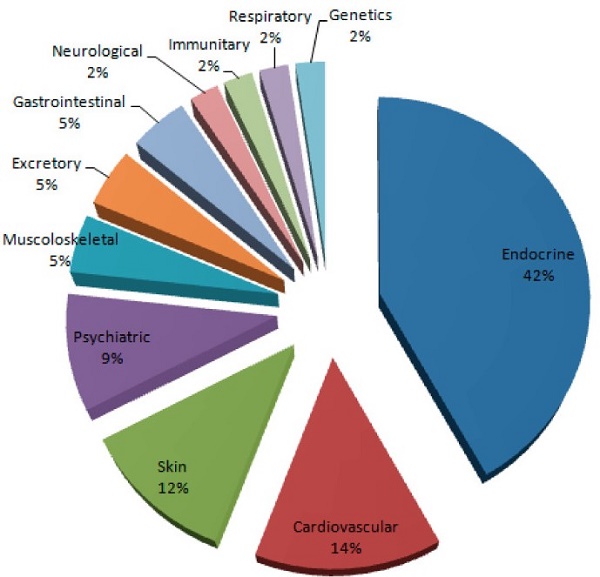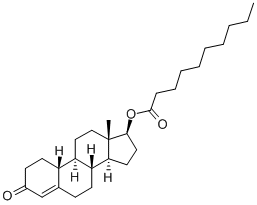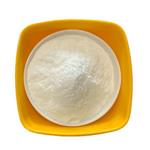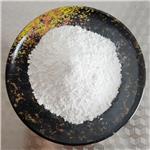Nandrolone decanoate, also known as nandrolone caprinate, is an alkylated anabolic steroid indicated in the management of anemia of renal insufficiency and as an adjunct therapy in the treatment of senile and postmenopausal osteoporosis. The process for creating esters of [nandrolone] was patented in Spain in 1959 and in 1960, it was described as having a long duration of action and strong anabolic effect compared to nandrolone and other esters. Nandrolone decanoate was granted FDA approval on 5 October 1962.
White or almost white, crystalline powder.
Deca-Durabolin,Organon,US,1962
Nandrolone Decanoate is an anabolic steroid. Nandrolone decanoate is used in the treatment of osteoporosis in postmenopausal women. Nandrolone Decanoate is also used for some aplastic anemias.
Control
led Substance.
ChEBI: Nandrolone decanoate is a steroid ester.
1 gram of 19-nortestosterone is dissolved in 3 ml of dry pyridine, after which
the resulting solution is cooled to -20°C. A solution of 1.0 gram of decanoic
acid chloride in 3 ml of dry benzene is added to the cooled solution. The
mixture is maintained at -15°C for 16 hours and then poured into ice water.
The aqueous liquid is extracted with benzene, the benzene solution is washed
with respectively 1 N sodium hydroxide solution, 2 N hydrochloric acid and
with water until neutral reaction.
Then the solution is dried on sodium sulfate, filtered, and evaporated to
dryness. The residue, 1.63 grams is dissolved in hexane, this solution is
filtered over 30 grams of neutral aluminum oxide, and evaporated to dryness.
On paper chromatographic investigation it turned out that the obtained 19-
nortestosterone 17-decanoate which at room temperature is an oil consists of
a single compound, according to US Patent 2,998,423.
Durabolin
(Organon);Abolon;Activin;Anabolin la 100;Anador;Anadur;Analone-50;Androlone d 100;Androlone d 50;Decabolin;Deca-durabolin decanoate;Deca-noralone;Docabolin;Fherbolico;Fortabolin;Hybolin-decanoate;Iebolan;Kabolin;Keratyl;Methybol-depot;Nandrolone decanoate;Nordecon;Stenabolin;Sterobolin;Turinabol-depot.
World Health Organization (WHO)
Nandrolone decanoate, an anabolic steroid, was introduced in
1962. In 1982, low dosage preparations were prohibited in Bangladesh due to
inadmissible promotion of products containing anabolic steroids for malnourished
children. Higher dosage preparations of nandrolone decanoate remain available in
many countries, including Bangladesh, for several highly specific but limited
indications that apply to patients with chronic debilitating and emaciating
diseases, particularly associated with neoplasia and some types of aplastic
anaemia.
Nandrolone decanoate,17β-hydroxyestr-4-en-3-one 17-decanoate, has been used inthe management of certain anemias, but the availability oferythropoietin has greatly reduced this use.
Compared to testosterone propionate, nandrolone decanoate is considered to have strong anabolic effects but weak androgenic effects (potency ratios of 3.29–4.92 and 0.31–0.41). In particular, nandrolone esters are thought to have the highest ratio of anabolic to androgenic effects of any AAS. The low androgenicity of nandrolone decanoate is thought to be due to the fact that nandrolone is inactivated by 5α-reductase via transformation into the low-affinity androgen receptor (AR) ligand 5α-dihydronandrolone. This is thought to result in a lower incidence and magnitude of side effects.Nandrolone decanoate (ND) injection has been classified as a Schedule III controlled substance under the Anabolic Steroids Control Act of 1990. Due to serious health risks, the nonmedical use of AASs is banned by most sports organizations[1].
There are many effects of this drug on the human body, and the studies of its side effects can be divided into the following: categories endocrine, cardiovascular, skin, psychiatric, musculoskeletal, excretory, and gastrointestinal disorders.

The most common side effects were: endocrine disorders (virilization, gynecomastia, hormonal disorders, cholesterol and lipid disorders, genital and infertility issues); cardiovascular disorders (vascular damage, coagulation disorders, arteriosus hypertension); skin disorders (pricking, acne, skin spots); psychiatric disorders (aggressiveness, mood disorders, sleep disorders, anxiety); musculoskeletal disorders (tendon ruptures); excretory disorders (organ damage); gastrointestinal disorders (organ damage and liver adenomas); neurological disorders (seizures); immune disorders (chronic infection relapse; respiratory disorders (sleep apnea syndrome); genetic disorders (genetic damage)[1].
Experimental reproductiveeffects. When heated to decomposition it emits acridsmoke and irritating fumes.
Veterinary Drugs and Treatments
The principle use of nandrolone in veterinary medicine has been to
stimulate erythropoiesis in patients with certain anemias (e.g., secondary
to renal failure, aplastic anemias). It has also been suggested
for use as an appetite stimulant.




